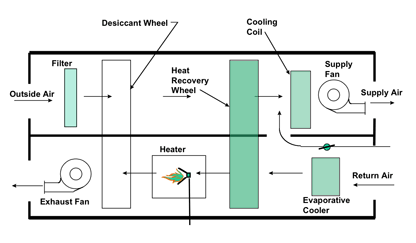desiccant cooling

Desiccant cooling system (courtesy AGA Gas Cooling Task Force).
Desiccant cooling is a new and potentially clean technology that can be used to condition the internal environment of buildings without the use of harmful refrigerants. Unlike conventional air conditioning systems, which rely on electrical energy to drive the cooling cycle, desiccant cooling is an open heat driven cycle, which uses a desiccant wheel and thermal wheel in tandem to achieve both cooling and dehumidification. Because it is a heat driven cycle, there is the potential to use environmentally cleaner sources of energy such as gas, hot water, waste heat or any heat source, including solar thermal energy, able to elevate the air temperature to a level adequate for reactivation.
Desiccant materials, which absorb moisture, can be dried, or regenerated, by adding heat supplied by natural gas, waste heat, or the sun. In most systems, a wheel that contains a desiccant turns slowly to pick up humidity from incoming air and discharge that humidity to the outdoors. Desiccant cooling can also be used in tandem with an conventional air conditioning system in which the desiccant removes humidity and the AC system provides cooling, and in energy recovery ventilators (ERV) to dehumidify incoming fresh air in the summer.
